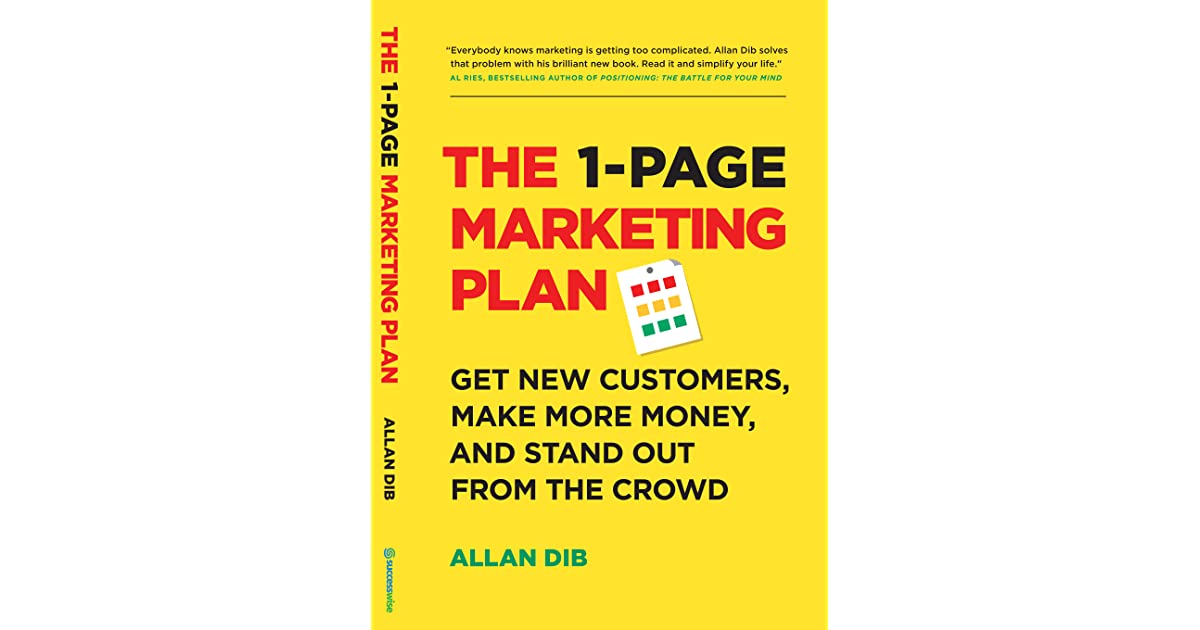What Media Will You Use to Reach Your Target Market
An analysis and commentary on The 1-Page Marketing Plan
The 1-Page Marketing Plan
About the Book:
In The 1-Page Marketing Plan, Allan Dib reveals a marketing implementation strategy to map out your own sophisticated marketing plan and go from zero to marketing hero.
About the Author:
Allan Dib is a passionate entrepreneur, rebellious marketer and technology expert. As a highly sought after business coach, consultant and public speaker, he frequently shares his proven strategies and cutting edge tactics with people all over the world.
THE CUT
Every good company has marketing and advertising strategies they use to promote their business. However, not every company is maximizing their dollar and their potential with each advertisement. John Wanamaker, who some consider to be the “pioneer of marketing” said, “Half the money I spend on advertising is wasted; the trouble is I don’t know which half.” It is easy to get caught up in finding multiple different outlets to reach your audience and quickly begin hemorrhaging money for it. It’s one thing if your ads are working, but in most cases your ads are only half as effective as they should be. You have to be selective in keeping what performs the best and ending the ones that only cost you money. Measuring and tracking what your customers are clicking on is the first step to successfully quantifying your ads producing power.
WHERE TO FOCUS
Depending on what form of advertising you use either print, social media, search engine optimization(SEO), or other channels each has different capabilities and limits. Understanding their potential to produce for you with regard to cost should be a priority. You should constantly be checking your return on investment (ROI) for them. If it costs you more than you will make from it then its a failure, if the reverse is true then it’s a success. A lot of companies focus on quantity, how many different places can I put my name in order to be known? When they should be focused on how they get the people who would be concerned with their products to them. Targeting effectively with your ads will lower costs and provides a higher rate of success to entice potential customers. Let’s say you are selling a high performance yoga mat with a high price tag due to quality, the ad you have decided to run is an in-game pop-up for a largely played game. While your ad will be reaching a large audience, the demographic factors that make up that audience (most likely male gamers between the ages of 12 to 40) will not be enticed to buy from you. You will have spent more money putting this ad in a popular game with limited returns. Instead had you opted for a section in a fitness trends magazine or sponsored a stay-at-home mom who blogs you would have reached an audience that would have more desire for your product. The audience would not have been as large but your turn-over rate would have been measurably better.
FINANCES
Larger companies have more spending power and more reach than small businesses so casting a wider net has less of a burdening impact on overall sales/customer acquisition. That doesn’t work for many small businesses. Money made up front on a campaign is known as “the front end,” while money made with subsequent purchases is known as the “back end.” Putting these figures together make-up the lifetime value of a customer. Lifetime value and cost acquisition are the two key measures of marketing effectiveness. Without one your marketing campaigns are most likely costing your business instead of providing for it. The goal of your front end offer should be to at least cover the cost of acquisition, this makes advertising sustainable. Repeated purchases by existing customers after the fact is what makes advertising profitable. You can still track conversion rates and customer interactions with your ads but they have little to no value beyond telling you that your ad is existing rather than performing.
A SUCCESSFUL MARKETING CAMPAIGN
There are three main elements to a successful marketing campaign. Firstly, your target market which we covered in depth in the first article. You need to make sure you are targeting the right audience for the products you’re selling. Don’t cast a net too wide and don’t limit yourself by discounting markets you think aren’t as valuable. Second, your message which was covered in chapter 2 and the second article in this series. It should be clear, concise, and relevant. It should say everything pertinent for that sale about the company and product without forgetting the audience you are talking to. Finally, your media which is our main focus in this article. Media is the source you use to reach your target market. Radio, Tv, direct mail, telemarketing, the internet, and so on are all various forms of media you can use. With the expansion of technology and other platforms social media has become a fixed part of any marketing strategies. You can reach wide and niche all through the same media but it does come with some challenges. We will focus on a couple different options here and how they can be used to benefit or harm your campaigns.
YOUR PLATFORM: SOCIAL MEDIA
The first thing to remember is that social media by definition is a form of media, not a strategy. It’s not the ideal selling environment because it is a place people come to hang out and communicate, learn, or generally just browse. You can make people uncomfortable by overtly selling and constantly bombarding them with offers and pop-ups. Overuse of the different ways you can reach an audience like this can turn your potential customers off. If everytime they click on a site they are instantly met with a pop-up that interferes with their intention they are liable to begin associating your business with annoyance. One the positive side it is much easier to gauge customer reactions and engage in a dialogue with people through your ad which has not been the case through other sources. A neglected problem that has recently come up is the time drain on social media in order to reply to comments, build posts, content, and continually stay up-to-date. You have to be able to discipline yourself when it comes to your usage of social media. Some may say it’s “free” advertising because all it does require is your time and energy but that is only true if your time is worth nothing. Another problem is that of ownership, your social media page and profile is the property of the social network. So when you build up your profile and audience you are building up their assets as well. You should instead use social media to drive traffic to your marketing assets such as a website, e-commerce shop, or other outlets. Now your audience spends more time with you and for you instead of giving the network you’ve chosen more access to them.
YOUR PLATFORM: WEBSITE
Sometimes social media isn’t the best choice for your ads because your market may not hang out on its platforms. Another good way to reach your target is through a website. If you have one already your one step ahead. This is crucial for giving your customers not only information about your company and what you offer but also provides another avenue for sales and lead generation. Your website should help you build a database of subscribers that are interested in your product. This can be done with an email opt-in form and allow you to nurture customers that may not be ready to purchase immediately. An email list will also generate more returning customers through weekly newsletters or promotions that keep you at the front of their minds. Be careful not to send too many emails or unrelated content as it can get monotonous and drive your customers away.
YOUR PLATFORM: EMAIL
Now that we have an email list let’s expand on what your emails should say and how to maximize their efficiency. There are three big challenges to having successful emails. The first is getting your email delivered. Your website can help generate a larger volume of potential customers through email, without it your email acquisition is severely limited. The next challenge is getting those potential leads to open the email. One way you can entice them is with a compelling subject line with “hot press” words such as: deal, exclusive, new, limited time offer. Making sure your emails are also free of spammy words and an overwhelming amount of pictures or links also make your email more enticing. Finally, getting your leads to read the contents of your email. Some marketers have advocated for keeping emails to subscribers short. However, the length of your email isn’t the biggest problem but rather how much relative content is within it. If you have relevant, quality content written in a concise and clear manner it will get read. Taking the example of bloggers, many write long emails because they know exactly what their audience wants to read. So while the email is long it is highly compelling and relevant. On the other side another technique is to write a short summary in the body of the email that will entice the reader to click on a provided link, then bringing them back to your site.
When it comes to your media strategy, you should understand that email doesn’t replace postal mail, it complements it.
YOUR PLATFORM: POSTAL MAIL
While speed and efficiency are the hallmarks of the internet and technology today you should never discount other opportunities to connect with your target market. Physical objects are good at motivating people emotionally and moving people emotionally toward a desired action is what marketing is all about. Another good point for postal mail is that because of technologies vast power there are less people using postal platforms. Less clutter from enemy messages means more spotlight time for yours. You can also reach very different audiences with postal mail. Younger generations don’t subscribe as readily as previous generations, but if your looking for an older crowd then this platform provides more opportunity for you. A magazine or mini brochure for your company is more likely to be displayed in small businesses instead of scrolling Tv ads which may reach your target market better. It’s important throughout gaining information on different platforms that you don’t just pick and stick to one. You should try different strategies in different ways and find the best ROI for your work.
THE MONEY
There are three outcomes to spending your money on marketing. One your marketing fails (meaning you spend more than you profit). Two, you have no idea whether it was a success or failure because you didn’t measure the result. Three, your marketing is a success because you have turned more profit over than spending. In each of these scenarios there’s a simple course of action. If your marketing fails, change it up, there’s no point in dumping money into something that isn’t helping. If you can’t tell whether it helped or hurt go get some measuring tools! There are numerous available that are cheap and easy to apply to your business. If your marketing is a success then keep funneling more into the project. It should only continue to strengthen your consumer portfolio and increase your bottom line. Marketing on a budget is the best way to train yourself to require results. It not only protects you from over investing and costly endeavors but promotes good business practices. After you find a strategy that works you can easily pour unlimited resources into it that way you are continuously receiving the benefits. Best to fail often and cheap in the beginning testing headlines, platforms, and content in order to find the best possible combination. Another challenge that may arise from this is having too much demand, which is a great problem to have but many don’t know how to deal with. If it’s sudden then you need to look into bigger suppliers for your product/service. If it’s continuous consider raising your prices, you are now providing a high demand service which means not only is your product valuable but your time is too. These will all help to boost your bottom line and drive more quality clients toward your doors.
THE NUMBER ONE
The most dangerous number in business is the number one. Do you only have on source of leads? One major supplier? One major customer? Do you rely on one product or service to be your bread winner? Is there a linchpin in your company that can either make or break your future. If so you need to identify it, change it, or expand to improve it. What happens if your supplier has a malfunction that causes a shipment to be delayed? Your business will suffer, customers will lose faith and profits will lower. The most important relationship you can foster with your customers is one of satisfaction and loyalty. The term brand loyalty refers to a customer’s choice to only buy from a specific brand. Having your customers trust and loyalty be scrounged due to situations you could have prevented falls into bad business practice. In order to build not only a good business but a strong one that doesn’t fold due to unpredictable circumstances builds a great business. If there is a change in regulation or law that prevents your current main product from being sold then no problem, you’ve got a back-up. If your biggest paying customers fall on hard times no problem, you are constantly bringing in new clients. Jim Rohn, a famous American entrepreneur, author, and motivational speaker, has a famous quote on the matter, “You’ve got to think winter in the summer. It’s just too easy to get faked out when the sky is blue, and the clouds are fleecy. You’ve got to prepare for winter because it’s coming, it always does.” Whether it’s tomorrow when snow randomly falls or in fact 6 months away you should be prepared.
HIGHLIGHTS:
- Use only what will benefit you, cut unsuccessful endeavors as they appear and encourage success where you find it.
- Start with a budget that protects you in case your marketing plan fails. This way you don’t dig yourself into a whole on something that’s not working.
- Experiment with different kinds of ads, messages, and media. You never know what could be a big success for you.
- Track your ROI on your ads. It is important to always be measuring and updating your marketing strategy as the times change and protecting yourself from losing money.
- Expect the unexpected, never leave yourself open to a problem that could arise. You should never limit yourself to the number one. Expand, research, and prepare in case you encounter an unforeseen situation.
REFERENCES:
The 1-Page Marketing Plan: Get New Customers, Make More Money, And Stand Out From The Crowd by Allan Dib







July 15, 2025 @ 12:19 pm
Your comment is awaiting moderation.
http://clinicagaleno.com/# dónde puedo comprar viagra para hombre sin receta